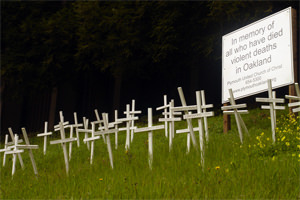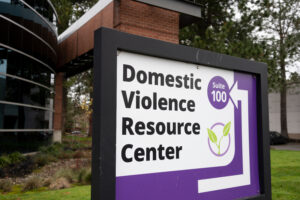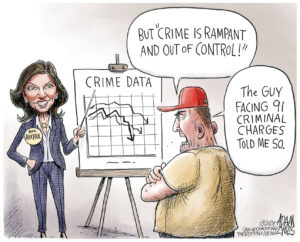The Invisible City: Entering Oakland
In 2006 alone, 148 people were murdered in the streets of Oakland, most of them African-American. Today the epidemic of violence continues unabated and largely ignored. Truthdig contributor James Harris reports on the forgotten crisis that threatens to tear his city apart.
The white woman, who had ridden with me before, jumped into my car at the casual car pool on Grand Avenue in Oakland, Calif., and we were off to work across the bridge to San Francisco. She was chatty, really chatty — an environmental lawyer currently working on an impossible case against the government for environmental abuse. We talked movies and Bush. Then she made a quantum leap:
“The killings in Oakland. Don’t they bother you? They’re all black — almost all of them.”
As a black man, I was struck initially by this white woman’s use of such racially blunt language, then startled by the introspection the question thrust upon me. We drove on, now at Treasure Island, about halfway through our ride; I was quietly trying to figure out just what the hell was going on in Oakland, now one of America’s deadliest cities.
Finally, after a half-mile or so, I said, “You’re right, they are mostly black, probably all black — all in ‘the flatlands.’ ” That’s what Oakland residents call the area between the 580 and 880 freeways, between the hills and the bay. “The idea is to live above 580,” Bryant Reed, another Oakland resident, once told me. That way you don’t have to worry about your kids getting shot on the way home from school. Back in the car, my companion chimed in. “I saw that statistic on the news,” she said.
The next mile or two was dead silent. We shared a listen to AM talk radio and then joined the host in a vociferous assault on President Bush. I pulled up to the bus station, the car-pool drop-off, and we said our goodbyes.
I drove on and wondered why it was so easy for us to talk movies and berate the wastrel president but, fully aware of the murders flooding our city, we sat paralyzed, able only to accept the lethal violence that Oakland’s streets dole out.
After the drive, I was in a strange fog. I was in a bigger city, surrounded by people, some of whom shared my experiences, most of whom did not. I was there, but not really. That night, I found myself pondering my blackness (my indirect role in the murders) as I read Ralph Ellison:
You ache with the need to convince yourself that you do exist in the world, that you’re a part of all the sound and anguish, and you strike out with your fists, you curse and you swear to make them recognize you. And, alas, it’s seldom successful.
In “Invisible Man,” Ellison talks about his protagonist feeling trapped in a world that fails to recognize his identity — thus making him “invisible.” Oakland’s black, dead and dying youths have become invisible, too. We hear the gunshots and see the blood spill but, in our minds, it’s only an episode on television. It cannot be real life; it cannot be real blood. It is something dark and frightening, buried deep in our imagination.
I have read the stories before in The New York Times, about the way we treat black death and white death, but there’s more to this story. This is about failed humanity. And everyone — every race and class — is a guilty accomplice to these murders.
The Low-Level Hustle
It’s a kind of “low-level hustle” that kids from the “flatlands” will tell you about if you just ask. “These fools will shoot you in a minute, for nothing,” says former Oakland resident Shayla Monique as she talks to me about the shooting of her ex-boyfriend in front of the 7-Eleven store on Bancroft in the flatlands. A boy rudely drove his bike into Shayla as she and the boyfriend, Jermaine, entered the store. Wanting to speak out on his girlfriend’s behalf, Jermaine yelled to the boy peddling away, “You can’t say excuse me?” “The next thing I know,” Shayla says, “the boy opened fire.” Jermaine, who survived, was shot six times, including shots to the chest, neck and stomach.
Hanging out in the flatlands, hearing these stories again and again, I realize that there my life is worthless and so is yours. If you stand in the way of the flow of drugs or dollars or you disrespect the wrong punk kid, you will be dead — count on it. There seemed to be a time, former Oakland resident James Randall says, “when black folks wouldn’t kill other black folks. We had to worry about white men killing us. Now, it could be said that I feel safer around white people than I do my own.” The news on Oakland has become some weird expo on violence and works only to confirm the worst stereotypes about the city and its people.
The media ignore the problem as an epidemic, and instead treat these murders — the victims mostly poor and black — as an occasional statistic. They fail to address the killings as black genocide, a genocide that is far worse, nationwide, than the American casualty rate in Iraq. Not to diminish the importance of bringing our boys home, but we have American boys dying right here in American streets. And the media, perfectly capable of mounting a movement or increasing awareness, cover the story as though it’s something we cannot change.
This is the story the San Francisco Chronicle filed on Jan. 27, 2007, after the mysterious death of Myisha Grazes:
The Alameda County Coroner’s Bureau has identified Oakland’s ninth homicide victim of the year as Myisha Grazes, who is believed to be in her 20s.
Anonymous callers to the police reported finding her badly beaten body at about 6:15 p.m. Thursday on the 9800 block of Stanley Boulevard, but provided no other information.
A police investigation into the murder is continuing.
If I were immune to the racial realities of the United States, this is where I would start asking ideologically sound rhetorical questions like, “If this were a white woman, would there be a stronger report in the news? Would people be up in arms about the death and the dying in general? Would there be countless panels and focus groups talking about ways to stop our children from dying?”
No rhetoric necessary when you’re dealing with a problem that’s invisible, a problem that people dismiss as some figment of their imagination. Myisha died, but it’s just a story about a girl who apparently had no family or friends, but was definitely in the right place to be beaten to death. Was her life not worth saving?
Murder has an all too familiar pattern in Oakland. The years 1992 to 1995 were the most deadly in city history, with as many as 175 killings in ’92 alone (compared with 148 in 2006). Crack cocaine was the plague responsible then, but now it’s anybody’s guess. Local news outlets have speculated that the violence can be attributed to drug wars or money exchanges gone wrong. Others say the crimes are due to rising gang violence between blacks and Mexican-Americans. I’ve spoke to many police officers, city officials and residents, but there seems to be no definitive answer as to why people are dying with such frequency in Oakland.
It’s not just Oakland that struggles with homicide. In fact, urban homicide in the United States should qualify as a national emergency. The eight most deadly and dangerous cities (according to 2006 research by Morgan Quinto Press) all are predominantly African-American. In each of these, blacks are more likely to be arrested than members of any other racial group, and blacks occupy most of the impoverished territory. St. Louis, Detroit, Flint (Mich.), Compton (Calif.), Camden (N.J.), Cleveland, Birmingham and Oakland all counted at least 148 homicides in 2006. The frequency of death by murder in St. Louis County is one slaying every 1.5 days — in 2006 220 were killed.
Each of the cities on the “danger list” has this commonality: Most residents know exactly where to expect murder rates to continue rising. It’s not an entire city being plagued by violence. What we are talking about here is homicides concentrated in black neighborhoods, with both assailant and victim typically being African-American.“If you ain’t been to the ghetto, don’t ever come to the ghetto. You wouldn’t understand the ghetto.” Naughty by Nature, circa 1991.
Living in Oakland is like living inside “The Strange Case of Dr. Jekyll and Mr. Hyde.” It is a city that reflects both poverty and prosperity. Walking through the North Oakland Safeway on College Avenue, I see couples and families shopping for organic products in a Disney-like scene. However, in West Oakland — about 10 minutes away — Grand Grocery is deserted. There is only the brave Afghan clerk in the dark and dirty store who scrutinizes each of his occasional customers.
Talking to residents around Grand Grocery, I discovered that many of them have lived in or near the neighborhood for most of their lives. Many have never left Oakland or even crossed the Golden Gate Bridge, which is less than 12 miles away. For as long as Oakland has had a problem with violence, the mayhem has come from East and West Oakland. Residents know where to go and where not to go. It’s like a game of musical chairs. If you want to live, just make sure you have a safe seat when the music stops playing and the lights go out.
As long as blood doesn’t spill on the safe streets and the violence stays where it is supposed to, Oakland residents, much as those in St. Louis or Camden, have proved again and again that they can live with the terror. With people being killed this brutally and this fast, it’s the only available coping mechanism. If you can’t change it, you got to stand it, I suppose.
The Mayor’s Raw Deal
For those who don’t know, Oakland had a celebrity mayor in former California Gov. Jerry Brown, whose so-called 10K Plan was great for business but not for the murder rate. There are about 10 new developments in Oakland, yet no new developments in the areas that need it most. There are more than 100 vacant acres in the city’s poorest communities. Brown held true to his promise to bring 10,000 residents to the downtown area (the 10K plan is still in the works), but he failed to illuminate the problem of crime and genocide. His ironic reward came in November, when he was elected California’s attorney general — the top cop.
What happens in Oakland now is, by and large, up to Mayor Ron Dellums, a Democratic fixture in the U.S. House of Representatives for 27 years who has now instilled hope in the more than 8,000 Oakland citizens who signed a petition pleading with him to run for mayor. Since taking office, Dellums swore that he will work tirelessly to turn Oakland into a model city. “If we can do it in Oakland, then the word is: ‘They did it in Oakland,’ ” said Dellums in an interview with Oakland Magazine.
Dellums’ ideas are grandiose, to say the least. He is calling for a decrease in crime, a new focus on quality education, ecological integrity, continued business development and a multimillion-dollar increase in the city budget. So far Dellums has put in place some 81 task forces around the city and has been determined in his effort to involve youths in the political process. Dellums also urged drug dealers and gang leaders at his Hyphy-Soul Showcase event to “come to the table on equal terms” and talk to him. Dellums cried out to the audience, “The senseless violence must stop!”
For those 8,000 Oakland citizens who signed the petition to get Dellums to run for mayor, he is a lot like Robert F. Kennedy, for he embodies the hopes of a broken people and he has the political know-how to turn Oakland around. The major criticism of Dellums is that he has yet to say how he will accomplish any of this, or what, exactly, he would do with an increased budget. But neither did RFK say exactly how he would take the hopes and dreams of millions and turn them into a presidential legacy.
There is no blueprint. There is no mayor who has solved these problems before. Oakland achieved modest success in reducing crime in the mid-1990s, but no mayor has ever systematically and successfully addressed the problems that plague black people in inner cities.
Ghost Town
The problems of Oakland, and other cities suffering from the failure or departure of industry, are paralleled in hip-hop, which has become plagued by violence rooted in a lack of tradition. The original form of hip-hop means nothing to artists aiming only to make a dollar; just as Oakland as the home of revolution in the 1960s means nothing to the children trying to survive on inner-city streets.
Hip-hop artist Nas recently released a magnificent album that discusses the “murder” of hip-hop in its original state: an energetic voice for young blacks. No violence. No killing. No hate. Just music. The song “Carry on Tradition” crescendos:
I feel it’s a problem we gotta resolve Hip-Hop been dead, we the reason it died Wasn’t Sylvia’s fault or ’cause MC’s skills are lost It’s ’cause we can’t see ourselves as a boss Deep rooted through slavery, self hatred The Jewish stick together, friends in high places We on some low level shit We don’t want brothas to ever win, see everybody got a label Everybody’s a rapper but few flow fatal It’s fucked up it all started from two turntables
First and foremost, black people must take ownership of this problem, but a sense of humanity obliges us all. If black children are dying in inner cities across the nation because they lack values, then why don’t the politicians who govern these districts pour every available resource into correcting the problem? More important, why aren’t neighborhoods banding together to discuss these issues? Why are there not more block parties and block socials sponsored by cities plagued by violence and lack of communication? These are the questions that Mayor Dellums is asking, the questions of a man who is trying to breathe life into a ghost town.
I will continue to report from Oakland, following the trials of the city and the progress of the mayor. I will speak to residents and tell you their stories, and endeavor to bring you the best and worst.
If you read this in accord, I hope you will join the struggle.
But if you read this and are not compelled to act, and act daily, remember that silence is compliance.
Your support is crucial...As we navigate an uncertain 2025, with a new administration questioning press freedoms, the risks are clear: our ability to report freely is under threat.
Your tax-deductible donation enables us to dig deeper, delivering fearless investigative reporting and analysis that exposes the reality beneath the headlines — without compromise.
Now is the time to take action. Stand with our courageous journalists. Donate today to protect a free press, uphold democracy and uncover the stories that need to be told.







You need to be a supporter to comment.
There are currently no responses to this article.
Be the first to respond.